| Yutong ZK6128BEVG (E12) | |
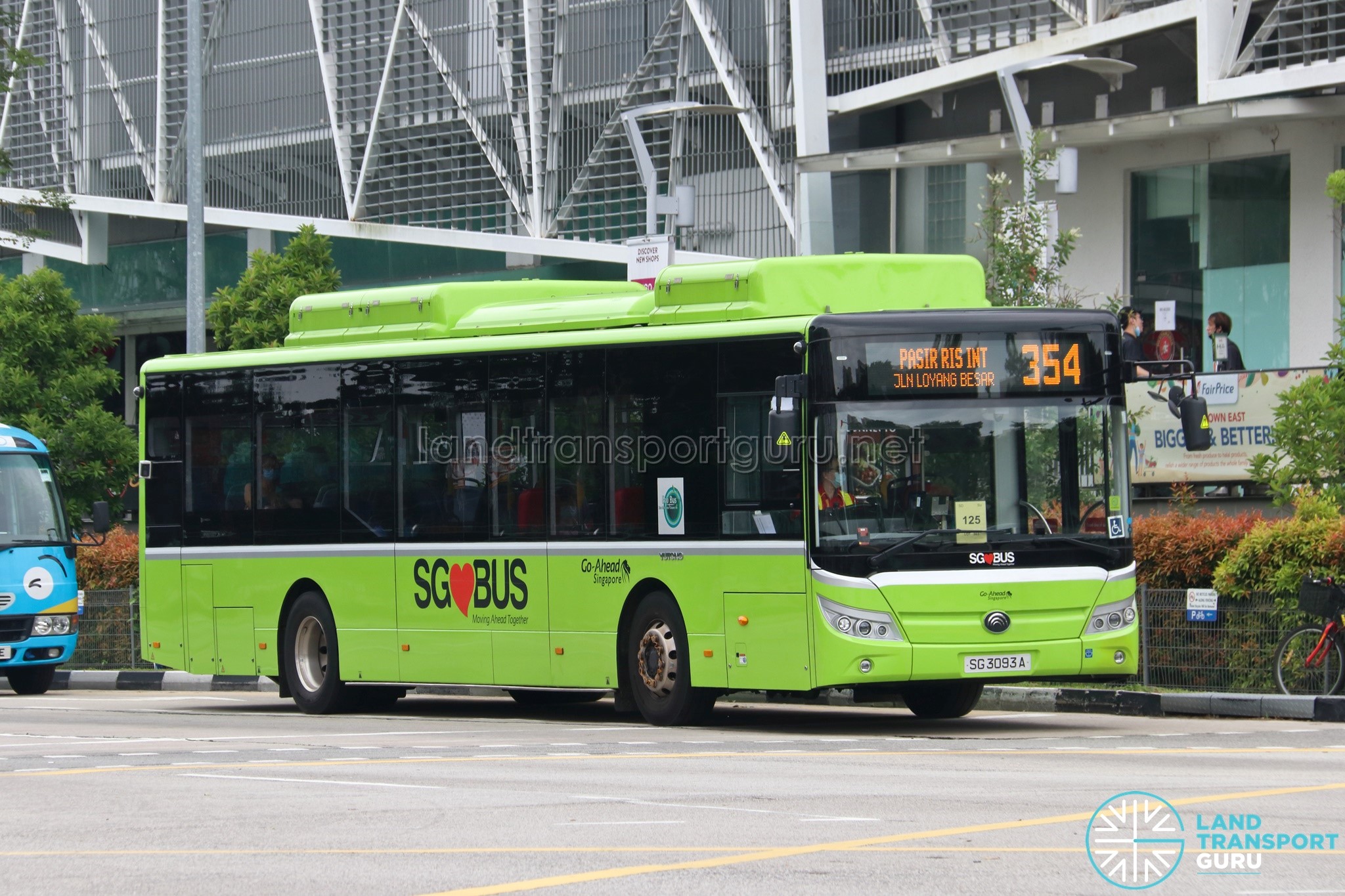 |
|
| Manufacturer | Zhengzhou Yutong Bus Co., Ltd. |
| Bodywork | Yutong Integral |
| Years in operation | 2020—Present |
| Operators | Tower Transit Singapore Go-Ahead Singapore SMRT Buses |
| Length | 12 metre |
| Motor | Permanent magnet synchronous motor |
| Battery | LiFePO4 (Capacity 375kWh) |
| Accessibility | Low Floor |
| Emission Standard | Zero tailpipe emissions |
The Yutong ZK6128BEVG (E12) is a fully electric single-deck city bus manufactured by Yutong in China. The Chinese manufacturer sells electric buses of different lengths and sizes for local and international markets.
10 units of the Yutong E12 bus were procured by the Land Transport Authority in 2018 as part of efforts to build a more environmentally friendly public bus fleet. A further 10 more Yutong E12DD double-deck electric buses would be acquired, for a total of 20 Yutong electric buses. In total, 60 electric buses were procured from three separate manufacturers at a total sum of S$50.64 million.
For Singapore road trials, buses are leased to Tower Transit (4 units), Go-Ahead (3 units) and SMRT Buses (3 units). Revenue service commenced on 3 April 2020, with buses initially deployed to Bus Services 15, 66, 944, 983 & 990. Overnight chargers were installed at Bulim Bus Depot and Loyang Bus Depot, supplied by NARI.
Bus operators in China are primary customers of the Yutong E12, with units operating in multiple Chinese cities. The bus has been successfully exported overseas, and as of 2020, units entered service in Santiago (Chile), Strasbourg and Marseille (France), Newport (UK), Reykjavik (Iceland), Helsinki (Finland), Roskilde (Denmark), Bergen (Norway), Sofia (Bulgaria), Nur-Sultan (Kazakhstan), and more.
Individual units have also been trialled in various parts of Australia, New Zealand and the United Kingdom.
Background
The Yutong E12 is marketed as a capable electric city bus featuring a suite of driver assistance features, passenger comfort and safety. The bus design incorporates large-capacity lithium iron phosphate batteries (375kWh) which allow the bus to travel roughly between 230 km and 300 km a single charge, under urban road conditions. The actual operating range is expected to be much lower in Singapore, where air-conditioning consumes a large portion of battery reserves.
Different range and power consumption figures have been quoted by different sources around the internet, depending on local route conditions under which the Yutong E12 was trialled. A range of 320 km has been quoted at 20°C without air-conditioning on. However, on Singapore road trials, the bus is confined to duties within 200 km, leaving an adequate margin of safety.
Yutong ReCtrl Electric Drive
Yutong's Electric Drive Technology (Click to expand) Yutong’s electric drive technology platform is called ReCtrl (or 睿控). In its most iteration, ReCtrl 4.0 (first released in 2017) combines four electric control technologies and four smart technologies as such: As illustrated by graphics produced by Yutong, the E12 splits its battery packs between the rear section and the roof of the bus. Singapore’s Yutong E12 buses appear to have the roof-mounted batteries split into two separate housing units; in front of and behind the air-conditioner, making for a split-type design. The Yutong E12 is a fully electric city bus manufactured by the Chinese company Zhengzhou Yutong Bus Co., Ltd (郑州宇通客车股份有限公司), which manufactures road vehicles (primarily buses). The E12 is just one of Yutong’s electric bus products, alongside hybrid and regular diesel buses. Photos of the Yutong E12 first appeared on the Chinese commercial vehicle website 提加商用车网 in September 2019. The bus is seen navigating a test track located within Yutong’s assembly plant in Zhengzhou, China. In comparison with Yutong E12 buses produced for other markets, the Yutong E12 buses in Singapore have the roof-mounted batteries split into two separate housing units; in front of and behind the air-conditioner, making for a split-type design. More information on the drivetrain can be found in the “Background” section above. All Yutong E12 buses were registered between January and February 2020 as SG3090H – SG3099J, with SMRT Buses, Tower Transit Singapore and Go-Ahead Singapore receiving these buses. Revenue service commenced on Friday, 3 April 2020, with buses deployed on Service 15, 66, 944, 983 and 990. The 10 Yutong E12 buses are registered as SG3090H – SG3099J. These buses, registered as YUTONG ELECTRIC ZK6128BEVG AUTO, were initially leased to the following operators: Revenue service commenced on Friday, 3 April 2020 with the deployment of these buses on: For SMRT Buses, the Yutong E12 is the second model of Yutong bus in its fleet. It previously trialled a Yutong ZK6126 diesel bus (registered SMB135E) between 2009 and 2010. The procurement contract for the Yutong E12 buses included the provision of charging infrastructure. 90kW DC plug-in chargers with CCS Type 2 connectors were installed at Bulim Bus Depot (14 chargers) and Loyang Bus Depot (8 chargers), supplied by NARI. In December 2024, SMRT Buses redeployed its Yutong E12 buses to Woodlands Depot, where 120kW DC chargers were installed by Strides Mobility. SMRT Buses subsequently redeployed the buses to the new Gali Batu Bus Depot in October 2025. The Yutong E12 buses were built by Yutong in Zhengzhou, China with integral bodywork, and shipped to Singapore as a Complete Built-Up (CBU) vehicle. The bus is painted in LTA’s standardized Lush Green base livery with ‘Eco Bus | Zero Emissions, Cleaner Air’ decals on both sides. In addition, only SG3098L is stickered with an advert promoting it as an electric bus. Other buses were progressively stickered in March 2022. The roof houses 6 battery banks split into two compartments. Batteries are supplied by Contemporary Amperex Technology Co., Limited (CATL), also from China. The Cling EZDS-06 air-conditioning system mounted in the middle of the roof. Typical for full-electric buses, the air-conditioning units rely on electrically-driven compressors, tapping on the bus’ high-voltage DC power supply (shared with traction motors) via its own set of inverters. The bus features 28 permanent seats. Being a low-floor bus, the bus offers step-free access from entry/exit doors until the last row of seats. Mood lighting in the bus cabin is offered in 3 colours—Dark Blue, Sky Blue and Orange. Like most single-deck buses in Singapore, the Yutong E12 buses are configured with two doors: an entrance door at the front, and an exit door in the middle. The entrance doors are conventional inward-swinging leaf doors, while the exit doors are outward-swinging plug doors. They are supplied by SMC Transit. Single seats are fitted above the front wheel arches. The front right wheel arch does not feature any forward-facing seats; it is instead occupied by a large electronics cabinet. The entrance door is no longer fitted with a centre pole as per older buses for the benefit of stroller boarding. Signs indicating no standing on the door movement area are printed on the floor. The bus features two wheelchair bays, both located opposite the exit door. They each accommodate one passenger-in-wheelchair (PIW), and are equipped with USB charging ports. Foldable armrests and a stroller restraint system is provided for wheelchair users and the securing of prams respectively. Seats were supplied by Ster of Poland (Model: New City) in Blue, with priority seats in Red. Priority seats, which are indicated in red seat covers, occupy the seats between entry and exit doors, as well as the first row behind the exit door. The red colour theme extends to the wheelchair backrests. A small metal storage rack is provided beside both rear-facing front priority seats for the benefit of commuters with bags or groceries. Grab poles and handgrips are located on both sides of the aisle. All seats also have handgrips to provide commuters with additional support. Yellow bus stopping bell-pushes are located around the bus cabin, mounted to stanchion poles. Some stanchion poles have areas around the bell also coated in yellow to aid with visual identification. Emergency hammers are located on pillars in-between windows. The rear section of the bus sits four abreast in forward-facing and rear-facing seats. One row of seats is eliminated from a typical single-deck bus design to accommodate rear-mounted battery packs and powertrain components.
— highly efficient electric motor replaces the traditional automatic transmission, offering smoother speed changes and reducing maintenance costs
— motor acts as a generator during braking, recovering kinetic energy into electrical energy which is stored in the batteries
— electro-hydraulic power steering requiring least steering effort
— automatically-adjusted heating/cooling with independent zone control, offering at least 15% energy savings over traditional vehicle air-conditioners
— overall management of energy consumption (such as drivetrain and auxiliary systems), using onboard electronic control units and CAN bus network
— air-conditioning compressor reacts automatically to deliver optimum cooling capacity
— key vehicle operating parameters are transmitted over the internet for health and status monitoring
— vehicle charging performance is recorded for monitoring
Introduction
Basic Technical Specifications
Electric Motor
Yutong permanent magnet synchronous electric motor;
Continuous power/torque of 120 kW / 1400Nm
Maximum power/torque of 240 kW / 2850Nm
Battery / Charging
CATL Lithium iron phosphate battery (Capacity 375kWh)
Charged via 90kW DC plug-in charger (CCS Type 2 connector) at Bulim / Loyang Depot; 120kW DC charger at Woodlands Depot
Range of at least 200km
Bodywork
Yutong integral bodywork (Steel monocoque structure). Built in Zhengzhou, China.
Full low-floor configuration
EDS
LECIP Electronic Display Sign
Orange LED Matrix; Mounted on Front, Left side and Rear
PIDS
LECIP OBC-VISION Passenger Information Display System
LED text displays, LCD display screens, interior speakers & exterior speaker
Driver Assistance
TNT Surveillance T-Guard
– Forward collision warning system (T-FA Front Alert Camera)
– Side collision warning system (T-SA Side Alert Cameras)
– Anti-Fatigue system (T-DA Driver Alert Camera)
– T-SEEDS telematics system
Passenger Capacity
28 Seated + 52 Standing = 80 Passengers
2 Wheelchair Bays
Additional Specifications
SMC Transit door systems
Ster New City seats
Cling EZDS-06 electric roof-mounted air-conditioning
TNT Surveillance T-APC automatic passenger counting system
ACTIA Podium 2 Dashboard
USB Charging Ports
Stroller restraint system
Interior mood lighting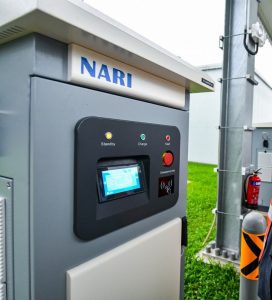
Fleet
Tower Transit Singapore
Go-Ahead Singapore
SMRT Buses
Charging Infrastructure
Exterior
Interior
Seating
Continued on Page 2:

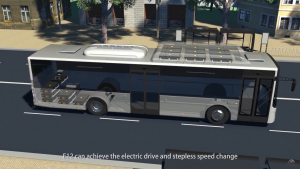

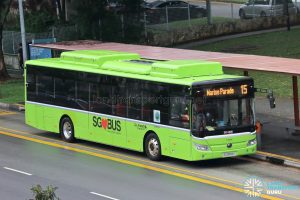
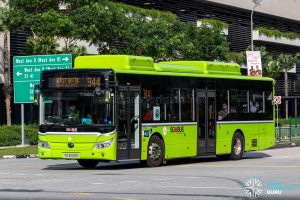
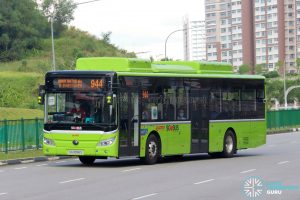
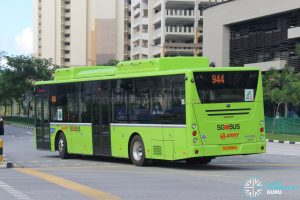
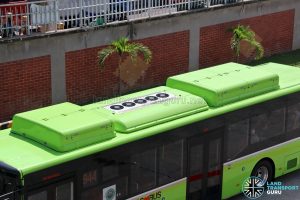


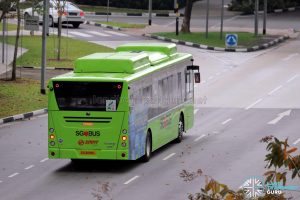
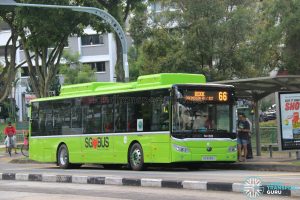

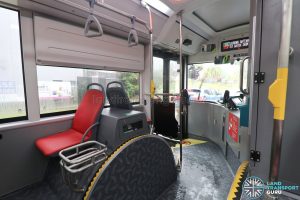
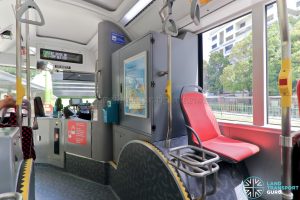
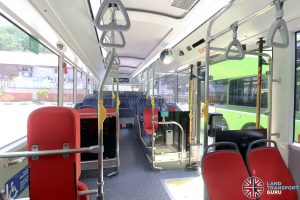
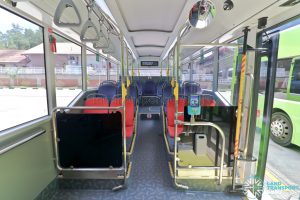
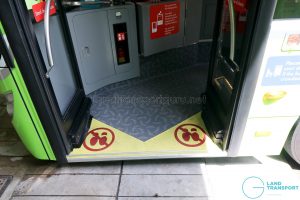
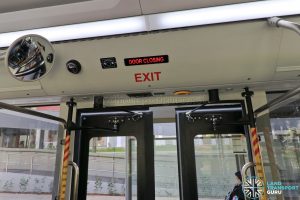
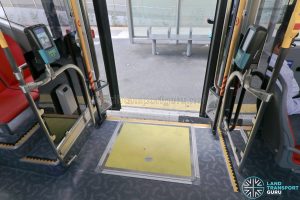

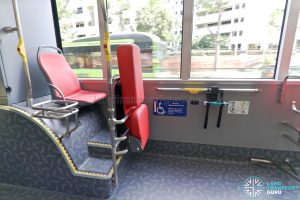
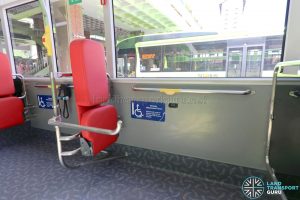
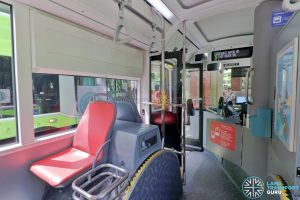
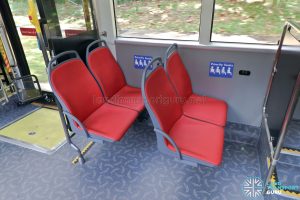

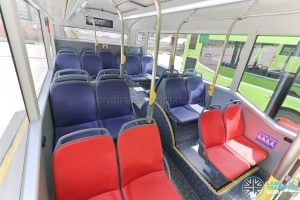
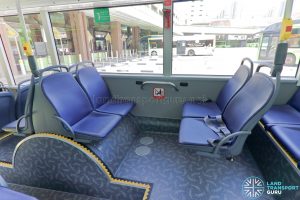
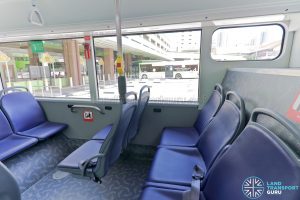
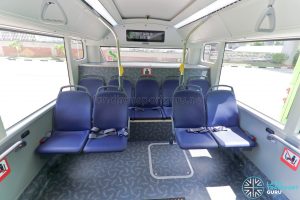
Earth Day wishes more electric buses to give Singapore air better
This ebus model is the best in terms of passenger comfort and experience. Perhaps LTA should consider buying large quantities of the E12 SDs in its next bus purchase to replace the KUBs and OC500LEs.
For the Yutong E12 electric buses under SMRT (services 944 & 983), they will park at Bulim Bus Depot.
maybe tower dont like man for some rsn thats why they were reluctant to trial sg5999z but lta forced them to…
TTS deployment is superb having svc 66 & 990 as a test bed for the Yutongs..66 endurance test from Jurong East to Bedok and 990 from Bukit Batok to Jurong East.For Bukit Batok there’s option to deploy on 106 also.
SMRT only short feeder for 944 and one of the bus is on split duty while the other is from CCK ie 983.Actually can just deploy to 985 and 184 since both also park at Bulim Depot.
TTS deploy all on svc 15,Can deploy 1 bus for Punggol svc like 34 or 82.
g-as deploy on 15 not tts
@Pubg But the redeployments honestly suck. Now all of them run on fairly short routes.